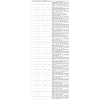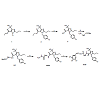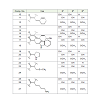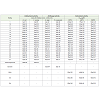Research Article
Schiff’s Bases Derived from Amino Acids-Imidazole Conjugates as Promising Antioxidant and Antimicrobial Agents
BJ Ullas1, PG Chandrashekar1, R Suhas2, KP Rakesh2, P Avinash2 and D Channe Gowda2*
1Department of Chemistry, Yuvaraja’s College, University of Mysore, Mysore-570 008, Karnataka, India
2Department of Studies in Chemistry, University of Mysore, Manasagangotri, Mysore-570 006, Karnataka, India
Corresponding author: D. Channe Gowda, Department of Studies in Chemistry, University of Mysore, Manasagangotri,Mysore-570 006, Karnataka, India, Tel.: +91 821 2419664; E-mail: dchannegowda@yahoo.co.in
Citation: Channe G, Ullas BJ, Chandrashekar PG, Suhas R, Rakesh KP et al. Schiff’s Bases Derived from Amino Acids-Imidazole Conjugates as Promising Antioxidant and Antimicrobial Agents. J Chem Applied Biochem. 2015;2(1): 116.
Copyright © 2015 Channe Gowda D et al. This is an open access article distributed under the Creative Commons Attribution License, which permits unrestricted use, distribution, and reproduction in any medium, provided the original work is properly cited.
Submission: 29/09/2015; Accepted: 02/11/2015; Published: 10/11/2015
Abstract
A series of amino acids conjugated imidazole derivatives were synthesized and characterized by standard spectroscopical techniques. The title compoundswere evaluated for their in vitro antimicrobial activity against bacteria and fungi by zone of inhibition method. The results showed that this skeletal frameworkexhibited interesting potency as antimicrobial agents. Amongst, compounds 10,11,13,14,16,17 and 18 showed most potent gram negative and gram positiveantibacterial activity whereas compounds 11,12,14,15,17 and 26 displayed most potent antifungal activity against A. niger and compounds 16,17,18, 21,22and 24 exhibited good antifungal activity against F. oxysporum species. On the other hand, conjugates 11,12,13,14,15,16,17 and 18 showed very goodantioxidant activity compared to commercial standard drugs. The results highlight the amino acids conjugated imidazole derivatives as potential leads fordesigning new future antimicrobial drug candidates possessing good antioxidant properties.
Keywords: Imidazole; Amino acids; Conjugation; Antimicrobial activity
Introduction
Heterocyclic compounds of nitrogen containing five memberedring systems have been described for their biological activity againstvarious microorganisms [1]. Besides this, the chemistry of imidazoleshas also been reviewed in literature and a number of derivatives ofimidazoles serve as valuable therapeutic agents [2]. Considerableinterest has been created in the chemistry of imidazoles due to theirversatile therapeutic activities like antibacterial [3,4], antimalarial[5], antihypertensive [6], antidepressant [7], antitubecular [8],antiviral [9], antiepileptic [10], antirheumatoid arthritis [11],anti-inflammatory [12,13], anticancer activities [14,15] etc. Theemergence of powerful and elegant imidazole has stimulated majoradvances in chemotherapeutic agents of remarkable significance inmedicine, biology and pharmacy. Besides this, it is also reported that imidazole compounds are one of the effective antifungal agents [16].Considering the importance of imidazole, we planned to incorporatethis crucial moiety in the design of our project.
On the other hand, earlier reports have shown that conjugation ofdifferent amino acids/ peptides to various biologically active scaffoldshas fetched remarkable results which are very promising and evenenthusiastic [17-19]. Further, amino acid/ peptide-based drugs havelow toxicity, ample bioavailability and permeability, modest potencyand good metabolic and pharmacokinetic properties [20]. Promptedby all these observations and with a further interest to developmore biologically active compounds, the present work encompassesthe synthesis of novel imidazole-based amino acids analogues aspromising antimicrobial and antioxidant agents.
Material and Methods
General
Imidazole 1 was gifted from Jubilant Life Sciences Ltd, all otherchemicals and reagents were obtained from Merck (India) andAvra Synthesis (India) which were used directly. Melting pointwas determined on a Superfit melting point apparatus (India) andis uncorrected. FT-IR was performed using a Jasco spectrometer(Japan) using nujol media. 1H NMR (400 MHz) and 13C NMR(100 MHz) spectra were recorded on a Agilent Technologiesspectrometer (USA) using DMSO (d6) as solvent. High resolutionmass spectroscopic analysis was performed on a Bruker MicroTOFQII mass spectrometer in positive mode. Progress of the reactionwas monitored by TLC using silica gel coated on glass plates with thesolvent system comprising chloroform/ methanol/ acetic acid in theratio 98:02:03 (Rfa) and 95:05:03 (Rfb) and the compounds on TLCplates were detected by iodine vapors. Chemicals and reagents usedfor antimicrobial studies were of bacteriological grade.
General procedure for N-alkylation
Compound 1 (2.0 g, 0.008 mol) was dissolved in acetoneand added base K2CO3 (2.3 g, 2 mol) followed by slow addition of4-chlorobenzyl chloride (1.33 g, 0.008 mol). Reaction was maintainedfor 10 h at reflux (monitored by TLC), filtered K2CO3, evaporatedsolvent, cooled and recrystallized N-alkylated product 2 from ethanol.
General procedure for hydrolysis
Compound 2 (2.0 g, 0.0054 mol) was dissolved in methanol,added 0.1 N NaOH solution (0.43 g, 0.011 mol) and the reaction wasmaintained for 5 h at 50 °C. Completion of reaction was monitoredby TLC, cooled and pH was adjusted to 1-2 using dil. HCl solution.Compound was extracted into DCM, washed with water, evaporatedsolvent to obtain compound 3.
General procedure for conjugation of 3 with differentamino acids (HCl.NH2-Xaa-COOMe) where Xaa = Phe, Tyr,Trp, Pro, Met and Lys
To compound 3 (0.002 mol) and HOBt (0.305 g, 0.002 mol)dissolved in DMF (10 mL/g of compound) cooled to 0 °C was addedNMM (0.55 mL, 0.002 mol). EDCI (0.383 g, 0.005 mol) was addedunder stirring while maintaining the temperature at 0 °C. Reactionmixture was stirred for an additional 10 min and a pre-cooled solutionof HCl.NH2-Xaa-COOMe (0.631 g, 0.002 mol) and NMM (0.25 mL,0.002 mol) in DMF (10 mL) was added slowly. After 20 min, pHof the solution was adjusted to 8 by the addition of NMM and thereaction mixture was stirred over night at room temperature. DMFwas removed under reduced pressure and the residue was pouredinto about 200 mL of ice-cold 90% saturated KHCO3 solution andstirred for 30 min. The precipitated product was taken into CHCl3and washed with 5% NaHCO3 solution (2×100 mL), water (1×100mL), HCl (2×100 mL) and brine (1×100 mL). The organic layerwas dried over anhydrous Na2SO4 and solvent was removed underreduced pressure. The products so obtained were recrystalized fromether/petroleum ether to get conjugates 4 (Phe), 5 (Tyr), 6 (Trp), 7(Pro), 8 (Met) and 9 (Lys).
General procedure for the synthesis of hydrazides
Compound 4, 5, 6, 7, 8 and 9 (0.3mmol) was dissolved separately in ethanol (2 mL) and hydrazine hydrate (0.03 mL, 2 mol)was added slowly and the reaction was maintained at reflux for 12h. Completion of the reaction was monitored by TLC, evaporatedsolvent, cooled and poured into ice cold water. Solid separated wasfiltered and dried to obtain 4a, 5a, 6a, 7a, 8a and 9a respectively.
General procedure for the condensation of aldehydes to4a, 5a, 6a, 7a, 8a and 9a
To compound 4a, 5a, 6a, 7a, 8a and 9a (0.3 mmol) andbenzladehyde (0.3 mmol) dissolved in ethanol (10 mL/g) was addedfew drops of acetic acid as a catalyst which was maintained at refluxfor 15 h. Completion of the reaction was monitored by TLC, solventwas evaporated, cooled and poured into ice cold water precipitateis obtained and then filtered, washed with cold water to obtaincompound (10-27).
Antibacterial activity
In vitro antibacterial activity was evaluated against humanpathogens of both gram positive organisms namely X. oryzae andgram negative organisms namely E. coli by agar well diffusion method[21].
The microorganisms were inoculated in to the sterilized nutrientbroth and maintained at 37 °C for 24 h. On the day of testing, bacteriawere subcultured separately into 25 mL of sterilized nutrient broth.Inoculated subcultured broths were kept at room temperature for thegrowth of inoculums. Each test compound (10-27) and standard drugof 10 mg was dissolved in 10 mL of DMSO to get a concentration of1 μg/mL and further diluted to get a final concentration of 50 μg/mL.About 15-20 mL of molten nutrient agar was poured into each of thesterile plates. With the help of cork borer of 6mm diameter, the cupswere punched and scooped out of the set agar and the plates wereinoculated with the suspension of particular organism by spread platetechnique. The cups of inoculated plates were then filled with 0.1 mLof the test solution, Chloromphenicol solution and DMSO (negativecontrol). The plates were allowed to stay for 24 h at 37 °C and zone ofinhibition (mm) was then measured.
Antifungal activity
In vitro antifungal activity was evaluated against two fungalspecies namely A.niger, and F. oxysporum by agar well diffusionmethod [22].
The fungal strains were subcultured separately into 25 mL ofsterilized nutrient broth and compounds and standard drug (bavistin)of 10 mg was dissolved in 10 mL of DMSO to get a concentration of1 mg/ml and further diluted to get a final concentration of 50 μg/mL.Molten media of sabouraud agar of 10-15 mL was poured into thepetri plates and allowed to solidify. Fungal subculture was inoculatedon the solidified media. With the help of 6 mm cork borer, the cupswere punched and scooped out of the set agar. The cups of inoculatedplates were then filled with 0.1 mL of the test solution, bavistinsolution and DMSO (negative control). The plates were allowed tostay for 3 days at room temperature and zone of inhibition (mm) wasthen measured.
Antioxidant activities
DPPH (1,1-diphenyl-2-picryl-hydrazyl) assay
The radical scavenging activity of DPPH free radicals bysynthesized compounds were determined according to the reportedmethod [23]. Briefly, 50 μL of test compounds was mixed at differentconcentrations (25, 50, 100, 200 and 300 μg/mL) with 1 mL of 0.1 mMDPPH in methanol solution and 450 μL of 50 mM Tris HCl buffer(pH 7.4). Methanol (50 μL) only was used as the experimental control.After 30 min of incubation at room temperature, reduction in thenumber of DPPH free radicals was measured by reading absorbanceat 517 nm. BHT (butylatedhydroxytoluene) was used as controlsimilar to test concentrations. Percent inhibition was calculated fromthe following equation:

ABTS (2,2-azinobis-(3-ethylbenzothiazoline-6-sufonicacid) assay
The ability of the test sample to scavenge ABTS.+ radical cationwas determined according to the literature method [24] with slightmodification. The ABTS.+ radical cation was pregenerated by mixing7 mM ABTS.+ stock solution with 2.45 mM potassium persulfate(final concentration) and incubating for 12-16 h in dark at roomtemperature until the reaction was complete and absorbance wasstable. Absorbance of the ABTS.+ solution was equilibrated to 0.70(± 0.02) by diluting with distilled water at room temperature, then2 mL was mixed with different concentration of the test sample (25,50, 100, 200, and 300 μg/mL) and the absorbance was measured at734 nm after 6 min. The scavenging capability of ABTS.+ radical wascalculated using the following equation:
ABTS.+ scavenging effect (%) = [(Ac-As) /Ac] x 100
Where, Ac is the initial concentration of the ABTS.+ and As is theabsorbance of the remaining concentration of ABTS.+ in the presenceof compounds.
DMPD (N, N-dimethyl-p-phenylenediamine) assay
The DMPD radical scavenging ability of synthesized compoundswas determined by the Fogliano et al., method [25] with slightmodifications by Gulcin [26]. This assay is based on the capacity ofthe extract to inhibit DMPD.+ cation radical formation. Briefly, 105mg of DMPD was dissolved in 5 mL of distilled water. Then, 1 mL ofthis solution was added to 100 mL of 0.1 M acetate buffer (pH 5.3).DMPD.+ was produced by adding 0.3 mL ferric chloride (0.05 M) tothis solution. Different concentrations of standard antioxidants orsynthesized compounds (25-300 μg/mL) were added, and the totalvolume was adjusted to 1 mL with distilled water. One millilitre ofthe DMPD.+ solution was directly added to the reaction mixture.The reaction mixtures were incubated in the dark for 15 min. Theabsorbance was measured at 505 nm and percent inhibition wascalculated according to the formula:

Results and Discussion
Chemistry
Starting material 1 was subjected to N-alkylation using benzylchloride that resulted in 2 which was ascertained by the absenceof NH proton peak. Product 2 on saponification yielded 3 whichexhibited carboxylic acid peak in its PMR spectrum. This compoundwas conjugated with different amino acids to obtain 4-9 which didnot have COOH peak and showed –NH peak at δ ~8.00 (1H, s) in 1HNMR spectra. Compounds 4-9 was separately reacted with hydrazinehydrate to get 4a-9a which was confirmed by disappearance of –OCH3peak. The final imines 10-27 were synthesized by condensation of 4a-9a with substituted aldehydes (Scheme). Synthesis were confirmed bythe presence of all requisite peaks and absence of extraneous peaks in1H NMR and 13C NMR spectra and also mass values were in accordancewith the mol. wt. calculated. The analytical and spectroscopic data ofthe synthesized compounds are given in Table 1.
Biological evaluation
Antimicrobial activity
The Schiff bases of imidazole-amino acid conjugates wereevaluated for their antibacterial studies against both gram-positiveand gram-negative bacteria namely X. oryzae and E. coli respectivelyand antifungal studies against A. niger and F. oxysporum. Synthesizedcompounds exhibited a significant broad spectrum inhibitory effectagainst all the tested microorganisms. The result obtained as zoneof inhibition (mm) is presented in Table 2. The standard drugschloromphenicol and bavistin were used as standards for antibacterialand antifungal activities respectively.
Previous reports have shown that there is no significant activitywith just imidazoles linked amino acids [27,28]. Further, derivativesof amino acids-heterocycle conjugates have exhibited promisingresults and in continuation it was decided to introduce differentaldehydes viz. dihydroxy, trihydroxy and trimethoxy benzaldehydein the present study to obtain imines 10-27. Among the twentynaturally occurring amino acids, selective moieties like Phe, Trpand Tyr (aromatics); Pro (an imine); Met (thio) and Lys (basic) wereused in the current investigation. Amongst, compounds 10-18, 21and 27 appeared to be more active than the standards which maybe due to the presence of aromatic side chains in Phe, Trp and Tyrand also could be due to more hydrophobicity of these amino acidsalong with the presence of more electron donating groups like OHand OCH3 present on the other end of the molecules. Together theseparameters would have contributed to the superior activity. Andalso it is observed that compounds with trihydroxy benzaldehydederivatives have shown enhanced activity compared to rest of theanalogues which imparts that these hydroxyl functions play a key rolein enhancing the activity. On the other hand, compounds containingthio group (22-24) have shown slightly decreased activity than Pro(19-21) which are further less active than Lys (25-27) analogues and this trend in activity reveals that presence of basic moiety is morehelpful in obtaining good results. Further these compounds are foundto be more selective in arresting the growth of A. niger fungus thanF. oxysporum.
In vitro antioxidant activities of all the synthesized compoundswere evaluated by (i) 1,1-diphenyl-2-picryl-hydrazyl (DPPH) assay,an convenient technique for screening the antioxidant activities of the antioxidants; (ii) 2,2-azinobis-3-ethylbenzothiazoline-6-sufonicacid (ABTS) cation radical assay which is a conventional andexcellent model for assessing the antioxidant activities of hydrogendonating and chain breaking antioxidants [29]; and (iii) N,Ndimethyl-p-phenylenediamine dihydrochloride (DMPD) cationradical assay which is similar to the DPPH radical scavenging assay.The IC50 values is the effective concentration at which 50% of the radicals were scavenged, were calculated to evaluate the antioxidantactivities. A lower IC50 value indicate greater antioxidant activity. IC50values of lower than 10 mg/mL usually implied effective activitiesin antioxidant properties [30]. The IC50 of butylatedhydroxylanisole(BHA), ascorbic acid (AA) and gallic acid (GA) was also determinedfor comparison. The results are presented in Table 2.
Most of the synthesized analogues showed potent antioxidantactivities especially 11, 12, 13, 14, 15, 16, 17 and 18 showed excellentradical scavenging activities with IC50 values 25, 35, 35, 20, 35, 30,20 and 30 μg/mL respectively in DPPH assay much better thanthe standard BHA (IC50 = 55 μg/mL). In ABTS+ radical scavengingassay, the compounds 11, 12, 13, 14, 15, 16, 17 and 18 showed potentantioxidant activity with IC50 values 35, 40, 35, 30, 40, 35, 25 and35 μg/mL respectively which is much better than the commercialstandards AA (IC50= 55 μg/mL). The compounds 11, 12, 13, 14, 15, 16, 17 and 18 also exhibited striking antioxidant activity with IC50values 35, 40, 40, 30, 35, 35, 20 and 40 μg/mL respectively whichis better than the standards BHA (IC50 = 50 μg/mL), AA (IC50= 60μg/mL) and GA (IC50 = 55 μg/mL) in DMPD assay. In all the threeassays performed, compounds 11, 12, 13, 14, 15, 16, 17 and 18 showedexcellent antioxidant activities with IC50 values much lower than thestandards. The IC50 values of these compounds have antioxidantactivities lower than 10 mg/mL demonstrating greater capacity in allthe three assays. On the basis of the above observation, compoundshaving –OH (phenolic), –indole and phenyl ring (11, 12, 13, 14,15, 16, 17 and 18) were found to be the most potent antioxidants.Conjugates with alkyl, imino and thio group showed least antioxidantactivity.
Conclusion
A novel series of Schiff base analogues of amino acids-imidazoleconjugates has been presented in this work. These compoundswere evaluated for antibacterial and antifungal activities by agarwell diffusion method. Activity profile revealed that compoundscontaining aromatic amino acids have shown profound results alongwith the beneficiary electron loving hydroxyl groups. Presence of thio(Met) and imino (Pro) amino acids have shown moderate activitycompared to Lys, a basic amino acid. These target molecules haveexhibited selective activity against A. niger fungal species and hencethese could be used to treat fungal infections. In case of antioxidantactivity compounds containing phenyl ring, indole ring and –OH(phenolic) group showed remarkable activity which may be due toelectron donating activity and resonating property of phenyl ring.Compounds like 22, 23, 24, 25, 26, and 27 showed least activity whichcould be be due to long alkyl group and also may be due to thio groupin methionine.
References
- Yu YB, Chen HL, Wang LY, Chen XZ, Fu B (2009) A Facile Synthesis of 2,4-Disubstituted Thiazoles Using MnO2. Molecules 14: 4858-4865.
- Grimmett MR (1970) Advances in Heterocyclic Chemistry. Academic Press, New York, 241-326.
- Jain AK, Ravichandran V, Sisodiya M, Agrawal RK (2010) Synthesis and antibacterial evaluation of 2-substituted-4,5-diphenyl-N-alkyl imidazole derivatives. Asian Pac J Trop Med 3: 471-474.
- Sharma S, Gangal S, Rauf A (2009) Convenient one-pot synthesis of novel 2-substituted benzimidazoles, tetrahydrobenzimidazoles and imidazoles and evaluation of their in vitro antibacterial and antifungal activities. Eur J Med Chem 44: 1751-1757..
- Boiani M, González M, Mini-Rev (2005) Imidazole and benzimidazole derivatives as chemotherapeutic agents. Med Chem 5: 409-424.
- Villalobos MR, Ibarra BM (2010) Synthesis, vasorelaxant activity and antihypertensive effect of benzo[d]imidazole derivatives. Bioorg Med Chem 18: 3985-3991.
- Hadizadeh F, Hosseinzadeh H, Motamed-Shariaty VS, Seifi M, Kazemi SH (2008) Synthesis and antidepressant activity of N-Substituted imidazole-5-Carboxamides in forced swimming test model. Iranian J Pharm Res 7: 29-33.
- Pandey J, Tiwari VK, Verma SS, Chaturvedi V, Bhatnagar S, et al. (2009) Synthesis and antitubercular screening of imidazole derivatives. Eur J Med Chem 44: 3350-3355.
- Sharma D, Narasimhan B, Kumar P, Judge V, Narang R, et al. (2009) Synthesis, antimicrobial and antiviral evaluation of substituted imidazole derivatives. Eur J Med Chem 44: 2347-2353.
- Puratchikody A, GopalaKrishnan S, Nallu M (2005) Synthesis and pharmacological evaluation of some Potent 2-(4-Substitutedphenyl)-4,5-Diphenyl-1H-Imidazoles. Ind J Pharm Sci 67: 725-731.
- Sisko J, Mellinger M (2009) Development of a general process for the synthesis of highly substituted imidazoles. Pure Appl Chem 74: 1349-1357.
- Navidpour L, Shadnia H, Shafaroodi H, Amini M, Dehpour AR, et al. (2007) Design, synthesis, and biological evaluation of substituted 2-alkylthio-1,5-diarylimidazoles as selective COX-2 inhibitors. Bioorg Med Chem 15: 1976-1982.
- Puratchikody A, Doble M (2007) Antinociceptive and anti-inflammatory activities and QSAR studies on 2-substituted-4,5-diphenyl-1H-imidazoles. Bioorg Med Chem 15: 1083-1090.
- Sharma GK, Kumar S, Pathak D (2010) Synthesis, antibacterial and anticancer activities of some novel imidazoles. Der Pharmacia Lett 2: 223-230.
- Baroniya S, Anwer Z, Sharma PK, Dudhe R, Kumar N (2010) Recent advancement in imidazole as anti cancer agents: A review. Der Pharmacia Sinica 1: 172-182.
- Narayana B, Vijaya-Raj KK, Ashalatha BV, Kumari NS, Sarojini BK (2004) Synthes of some new 5-(2-substituted-1,3-thiazol-5-yl)-2-hydroxy benzamides and their 2-alkoxy derivatives as possible antifungal agents. Eur J Med Chem 39: 867-872.
- Suhas R, Chandrashekar S, Gowda DC (2011) Synthesis of elastin based peptides conjugated to benzisoxazole as a new class of potent antimicrobials -a novel approach to enhance biocompatibility. Eur J Med Chem 46: 704-711.
- Suhas R, Chandrashekar S, Gowda DC (2012) A new family of highly potent inhibitors of microbes: synthesis and conjugation of elastin based peptides to piperazine derivative. Int J Pept Res Thera 18: 89-98.
- Suresha GP, Suhas R, Kapfo W, Gowda DC (2011) Urea/thiourea derivatives of quinazolinone-lysine conjugates: synthesis and structural activity relationships of a new series of antimicrobials. Eur J Med Chem 46:2530-2540.
- Gadek TR, Nicholas JB (2003) Small molecule antagonists of proteins. Biochem Pharmacol 65: 1-8.
- Perez C, Paul M, Bazerque P (1990) An antibiotic assay by the agar well diffusion method. Acta Biol Med Exp 15:113-115.
- Singh I, Singh VP (2000) Antifungal properties of aqueous and organic solution extracts of seed plants against Aspergillus flavus and A. niger. Phytomorphology 50: 151-157.
- Blois MS (1958) Antioxidant determinations by the use of a stable free radical. Nature 181: 1199-1200.
- Re R, Pellegrini N, Proteggente A, Pannala A, Yang M, et al. (1999) Antioxidant activity applying an improved ABTS radical cation decolorization assay. Free Radical Bio Med 26: 1231-1237.
- Fogliano V, Verde V, Randazzo G, Ritieni A (1999) Method for measuring antioxidant activity and its application to monitoring the antioxidant capacity of wines. J Agric Food Chem 47: 1035-1040.
- Gülçin I (2010) Antioxidant properties of resveratrol: a structure-activity insight. Food Sci Emerg 11: 210-218.
- Lee Y, Martasek P, Roman LJ, Masters BS, Silverman RB (1999) Imidazole-containing amino acids as selective inhibitors of nitric oxide synthases. Bioorg Med Chem 7: 1941-1951.
- Eldon EB, Peter BD (1996) Solid phase synthesis of polyamides containing imidazole and pyrole amino acids. J Am Chem Soc 118: 6141-6146.
- Leong LP, Shui G (2002) An investigation of antioxidant capacity of fruits in Singapore markets. Food Chem 76: 69-75.
- Lee YL, Yen MT, Mau JL (2007) Antioxidant properties of various extracts from Hypsizigus marmoreus. Food Chem 104: 1-9.




